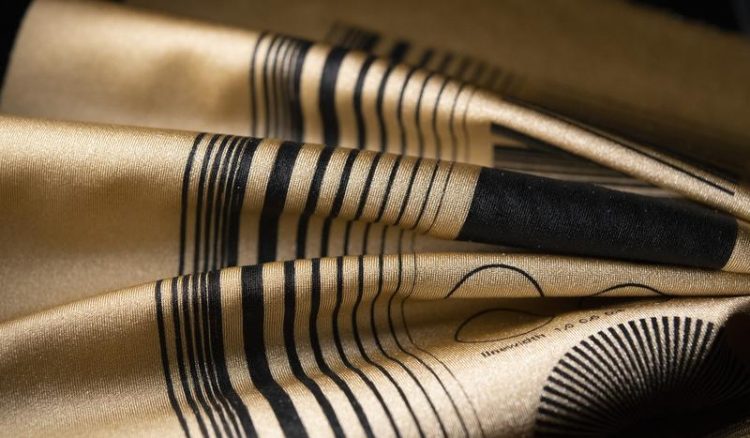Fusible and printable elastomer sensors for e-textiles

Sensor patterns and conducting paths printed on polyester textile. © K. Selsam for Fraunhofer ISC
By adding electrically conductive components, the silicone can be produced as a stretchable conductive foil, usable e.g. as flexible heating element. If alternating layers of conductive and insulating silicone are laminated together, stretchable capacitors are created that can be used to measure strain and pressure.
Depending on the application, the design and softness of the sensors can be adjusted. This allows tailor-made sensitivity and characteristic of the sensors according to the requirements of the customers.
The silicone used is skin-friendly, washable, robust and very flexible. Sensors made of this silicone withstand even extreme strains and very frequent use without losing their essential qualities.
The sensors convert mechanical strain into an electrical signal and are therefore also suitable for measuring signals of the human body, e.g. breathing, movement or muscle contraction.
In a current project CeSMa has further developed its elastomer sensors and their processing for integration into textiles. The stretchable sensors and actuators can now be applied to textiles by printing techniques or ironing.
The elastomer sensors can be applied permanently to polyester and cotton – the most commonly used textiles in the artificial and natural fiber sector – with a conventional iron in a short time (about 1 minute) even at low temperatures of 80 °C. Since the method allows an individual placement of sensor structures, it is especially intended for smaller quantities.
The desired structures can be produced separately as ironing films, so that in theory any sensor pattern and various functions can be combined. Also, different surface structures can be generated, ranging from “super smooth” to “highly structured”. The sensors can be ironed on very different textiles and are not only suitable for original equipment, but also for the retrofitting of textiles – even in private household.
With direct textile printing processes, sensor structures can be imprinted on the desired material in the shortest possible time. The process can be integrated very well into the further processing of the textiles. Very large quantities up to mass production are possible.
The printing process is technically more complex compared to ironing, but due to the higher number of produced pieces it is more cost-effective and therefore particularly interesting for larger manufacturers of textile goods.
Heating surfaces and pressure or strain sensors can be ironed or printed as needed. They can be connected with commercially available cables or with printed elastic conductive paths. This results in textile-integrated sensor and actuator systems that can be used to generate and/or control functions (heat, current pulses, flares, data processing).
https://www.isc.fraunhofer.de/en/press-and-media/press-releases/fusible-and-prin…
Media Contact
All latest news from the category: Trade Fair News
Newest articles

A new puzzle piece for string theory research
Dr. Ksenia Fedosova from the Cluster of Excellence Mathematics Münster, along with an international research team, has proven a conjecture in string theory that physicists had proposed regarding certain equations….

Climate change can cause stress in herring larvae
The occurrence of multiple stressors undermines the acclimatisation strategies of juvenile herring: If larvae are exposed to several stress factors at the same time, their ability to respond to these…

Making high-yielding rice affordable and sustainable
Plant biologists show how two genes work together to trigger embryo formation in rice. Rice is a staple food crop for more than half the world’s population, but most farmers…



